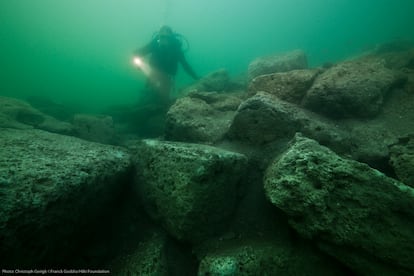In the midst of the exciting moment that archeology lives in Alexandria and its surroundings (finding of the monumental door of the lighthc. The dessert queen of Egypt, the popular Cleopatra of the novels and cinema. The submarine archaeologist Franck Goddio, who has been working for 30 years in the sunken eastern port of the ancient Alexandria – the Portus Magnus of Antiquity – and the submerged island of Antirhodos, considers that it can already offer a reconstruction of one of the most famous monuments of the area and the history of the city, the iseum, the famous temple of Isis, connected indissolively with the memory of Isis the great Cleopatra and “epicenter of his kingdom.”
Goddio and his Team of the Institut Européen d’Archéologie Sous-Marine (to which we must also find the ruins of Canopo) have gradually discovering, excavating and identifying the remains of the temple, of which they have found evidence that it functioned as a sanctuary for the personal cult of Ptolemy XII as neo-osiris-dionisios, and his daughter, and his daughter VII as nea -sis-Afroite. The temple of Isis on the island of Antirhodos – private proprition of the kings according to Estrabón – was one of the first buildings that the sailors saw when entering the Portus Magnus (after the lighthouse, it is understood).
The Ptolomeos, Egyptian dynasty of Greek origin (descendants of one of the generals of Alexander the Great, Ptolemy, who occupied the throne of Egypt), reigned from 323 before Christ to 30 a. C In a suggestive depravation, intrigue, crime and incest but also of extraordinary scientific and cultural development that had its last moment of Fulgor with the exit of Cleopatra VII scene that preceded Roman domination. In the context of a fruitful Hellenic-Gipcio miscegenation, the Ptolomeos mixed the Greek pantheon with that of the Nile country giving rise to syncretic cults (especially of the God Serapis) as the one that is manifested in the temple of Isis.
Now, Goddio collects his research and his proposal to restitution of the sanctuary in a publication The Iseum of the Royal Island of Antirhodospublished by the Oxford Center for Maritime Archeology (OCMA) in coincidence with Congress Alexandria and the sea held in Oxford last week and opened Goddio himself.
“Based on the archaeological findings, we can now rebuild the temple of ISIS very well,” said Goddio, to which the Hilti Foundation sponsored. “The investigation shows that the building had various phases of renewal and expansion before being destroyed by an earthquake at some point in the midst of the 50s after Christ.” The temple continued to receive donations and be redecored in Roman times. Findings of the Foundation Phase of the Monument in the third century Before Christ have allowed to identify the original enclosure as a temple to God Osiris, the Isis couple. The discovery of this oldest phase, highlights the researcher, has been possible thanks to the use of modern geophysical equipment that has allowed the team of archaeologists to carry out very localized excavations in the oldest strata in the temple.
Numerous objects of the time of Cleopatra VII and his father Ptolemy XII, known with the nickname of Auletes (the flutist) and more risky as Nothos (the bastard) and that was largely a puppet of the Romans, have appeared in the excavation of the temple, including 21 silver and bronze medals of the monarchs. Other elements of the Treasury of the Sanctuary, eight -meter granite columns, statues, part of the decoration and fragments of mosaic has also been found. The findings also include part of frescoes with preserved colored pigments.
Goddio and his team explain that the discoveries have occurred thanks to the fact that parts of the temple fell into the water in the port during the earthquake and those remains were thus protected from the cleanliness and removed from the ruins that remained on the ground. “Research in the Isis temple continues,” archaeologists point out, leaving effluvians of emotion and mystery in the air. They point out however that experts already classify the discovery of the “significant milestone” temple in the Cleopatra VII study. “Alexandria, with her real districts and the Royal Island of Antirhodos was the base of Cleopatra from where she reigned and forged alliances,” said Professor Damian Robinson from the University of Oxford. “With the discovery of the temple of Isis we are in the epicenter of his kingdom.” Nothing less.

